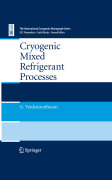
Most conventional cryogenic refrigerators and liquefiers operate with pure fluids, the major exception being natural gas liquefiers that use mixed refrigerant processes. The fundamental aspects of mixed refrigerant processes, though very innovative, have not received the due attention in open literature in view of commercial interests. Hundreds of patents exist on different aspects of mixed refrigerant processes. However, it is difficult to piece together the existing information to choose an appropriate process and an optimum composition or a given application. The aim of the book is to teach (a.) the need for refrigerant mixtures, (b.) the type of mixtures that can be used for different refrigeration and liquefaction applications, (c.) the different processes that can be used and (d.) the methods to be adopted for choosing the components of a mixture and their concentration for different applications. The author uses analytical methods based in sound thermodynamics to design mixed refrigerant processes Scores of examples and case studies which will help the reader understand the principles of cryogenic mixed refrigerant cycles Readers will be able to quickly understand the fundamentals of the various mixed refrigerant cycles and start their own work on this frontier research area INDICE: Fundamental principles and processes.- Simulation of cryogenic processes.- Need for refrigerant mixtures.- Constant temperature refrigeration processes.- Optimum mixture composition. -Natural gas liquefaction processes.- Cooling and liquefaction of air and its constituents.- References.- Index.
- ISBN: 978-0-387-78513-4
- Editorial: Springer
- Encuadernacion: Cartoné
- Páginas: 270
- Fecha Publicación: 01/08/2008
- Nº Volúmenes: 1
- Idioma: Inglés
